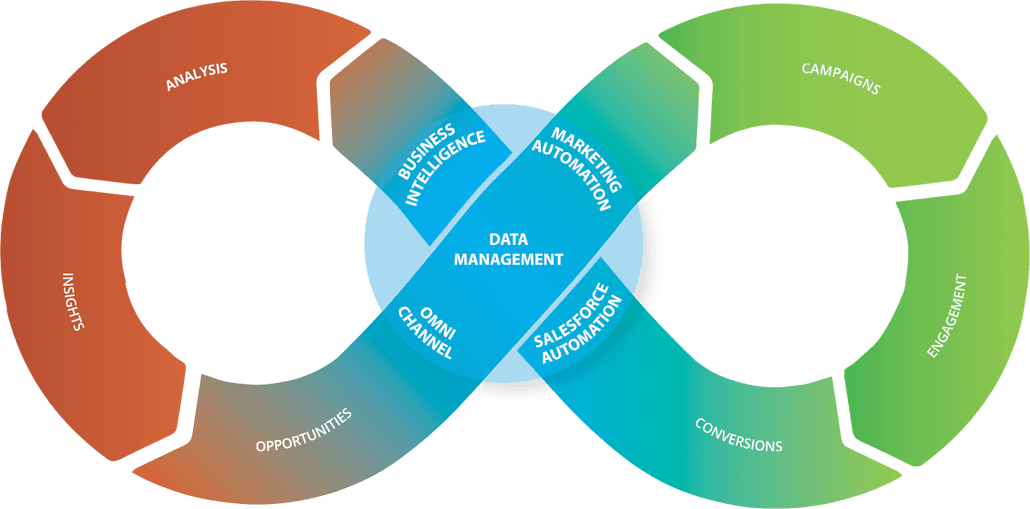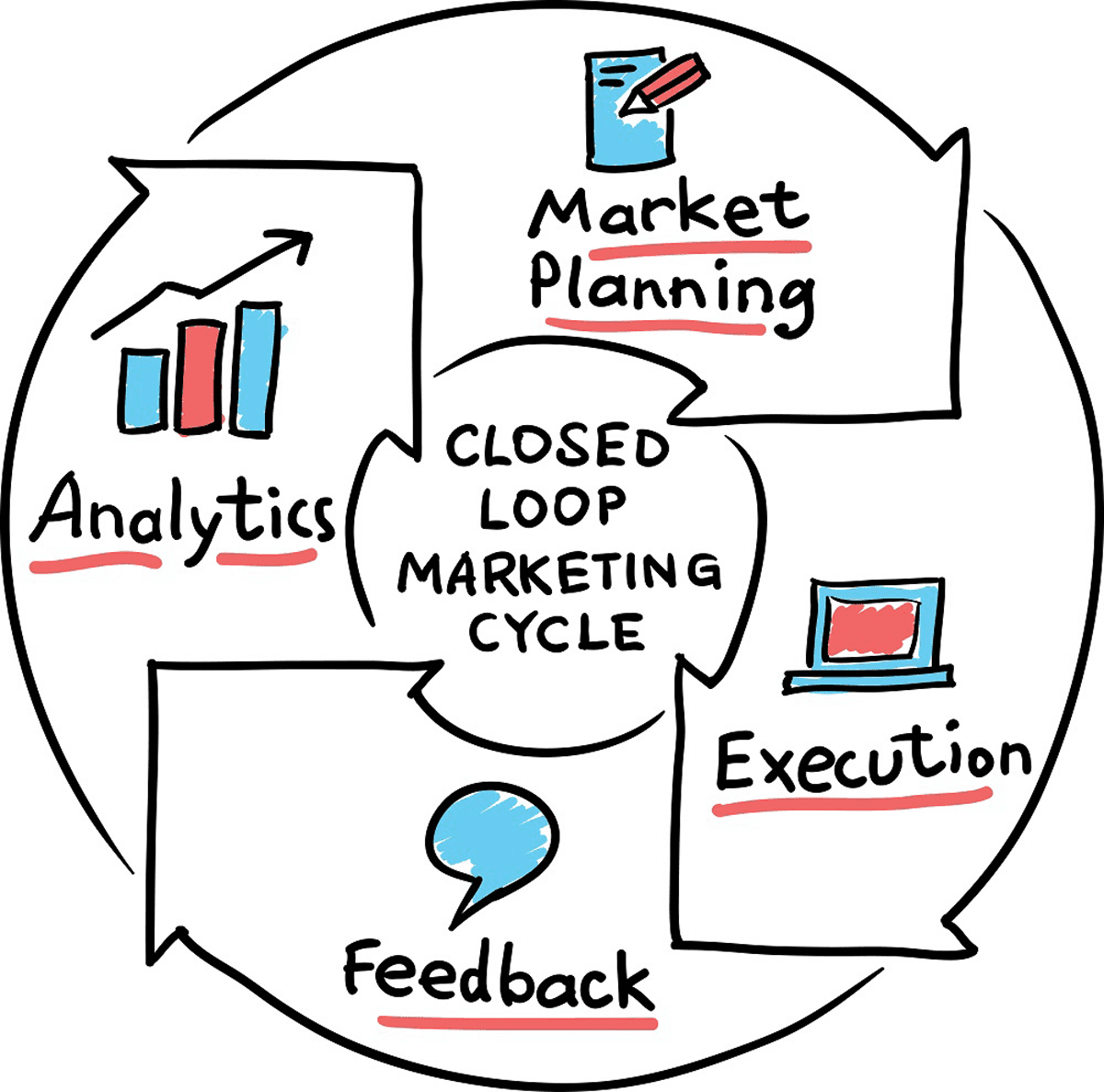What is Closed Loop Marketing?
Traditional marketing methods have always made it difficult for companies to reliably measure the return-on-investment (ROI) associated with their marketing efforts. If your organization relies on print ads, billboards, and television or radio spots to get the word out to prospective customers, how can you accurately determine which of these marketing sources led to a specific sale or conversion? In this paradigm, quantifying the real effectiveness of individual marketing efforts or campaigns is nearly impossible and marketing teams may end up wasting large amounts of their budget on channels that don’t produce the intended results.
Digital marketing makes it significantly easier for organizations to collect and analyze data from customer interactions and leverage that into more effective marketing campaigns that increase ROI. For organizations that sell B2B, closed-loop marketing is a useful methodology for tracking individual leads and customers throughout the entire sales cycle and using that data to continuously refine and optimize marketing spend and funnel design.
The defining feature of closed-loop marketing is the use of data analytics to track individual customers from their first interaction with your marketing funnel through the entire sales cycle. This helps your marketing team determine the most profitable and effective components of your marketing initiatives and get a better understanding of where your efforts are producing the greatest return-on-investment.

Closed Loop Marketing Explained
What loop are we closing with closed-loop marketing? Where exactly is the value generated?
To answer these questions, we need to understand how the customer journey works for most organizations. In most cases, the marketing team deploys marketing campaigns and content to generate leads and opportunities for the sales team. When an opportunity is created, it passes from the marketing department into the customer relationship management (CRM) tool and becomes the responsibility of sales.
Closed-loop marketing takes this process a step further by having the sales department report back to marketing on the success or failure of each opportunity. In this way, the marketing team can trace the path of a successful sale back through every touchpoint and to the original source of the lead.
Compared to the traditional hand-off method, closed-loop marketing makes it easier for marketers to measure channel-specific ROI and identify the lead sources that best correlate with revenue generation (instead of just lead or opportunity generation). It is also possible to automate reporting between sales and marketing with the right software tools, reducing the administrative overhead of your closed-loop marketing initiative.

Steps of an Effective Closed Loop Marketing Strategy
- Generate Website Traffic – Before you can track the behavior and outcomes of individual visitors to your website, you will need to generate website traffic, either organically from search engines or through paid advertising.
- Track Website Traffic Sources – Measuring your marketing ROI depends on being able to track the origins of traffic to your website. You want to know where individual visitors came from (social campaign, search engine results page, etc.) so you can track their entire customer journey from beginning to end. This is typically done by implementing tracking codes that attach to the end of your linked URL in each campaign.
- Behavior Analytics – When a visitor arrives on your website, marketing software is used to place a cookie on that person’s computer or web browser. Cookies are little pieces of data that allow you to track an individual user throughout all of their interactions on your web site, including page visits, length of stay, and other behaviors. Cookies tell a complete story about how an individual user interacts and engages on your website.
- Target-specific Content Delivery – Cookies can also be used to deliver target-specific content to prospective customers. Instead of showing the same content and offers to each visitor, you’ll be able to deliver personalized experiences depending on where a visitor originated and their browsing behaviors on your web page. This yields many opportunities to drive conversions by optimizing the customer experience for visitors from different marketing channels.
- Conversions, Sales and Feedback – When a lead converts into an opportunity, and later into a sale, you want to be able to track that customer’s entire journey. This is achieved through the integration of sales and marketing data that allows continuous tracking of individual customers from lead capture through to purchase. Marketing teams can then analyze this data to determine the best and most profitable channels and techniques for generating high-quality opportunities that lead to sales.
- Continuous Improvement – Closed-loop marketing drives value through continuous improvement and optimization of the marketing plan. By tracking individual prospects through the sales and marketing funnels, marketing teams get an end-to-end perspective of the customer journey and can better allocate resources to enhancing the profitability and effectiveness of marketing initiatives.
- ROI Calculation – One of the key benefits associated with closed-loop marketing is the ability to perform precise ROI calculations for marketing efforts by channel. Marketers can easily determine the most profitable lead sources and the most effective marketing channels for the brand, leading to demonstrable increases in marketing ROI.
What are the Benefits of Closed Loop Marketing?
Closed-loop marketing delivers significant benefits for organizations who use behavior tracking and data analysis technologies to facilitate end-to-end tracking of the customer journey. These include the following:
Focus on Most Important Revenue-Driving Channels
Marketers can easily identify which lead sources to drive the most revenue, even if they aren’t the ones that create the most leads or opportunities. Marketers can leverage past successes and failures into a deeper knowledge of which channels should be targeted to enhance ROI.
Reduce Cost-per-Lead
The ability to hone in on the most profitable lead sources means that your organization can reduce cost-per-lead, cost-per-conversion, and total customer acquisition costs by focusing on the right channels.
Promote Effective Goal-Setting
A clear understanding of how each marketing channel supports revenue and sales growth and target attainment is a great starting point for effective goal setting.
Enhance Return-on-Investment
Closed-loop marketing embraces data collection and analysis techniques to help marketers spend more on the channels that work and spend less on the channels that don’t. Wasting less time and fewer resources catering to channels that don’t drive revenue works out to enhanced marketing ROI for your organization.

Directive Consulting Puts Data First with Closed-Loop Marketing Strategy
At Directive Consulting, we leverage our years of experience and developed expertise in closed-loop analytics to help our customers market more effectively to their prospective customers.
Using data analytics and insights to close the loop between sales and marketing helps us refine your marketing plan to target the most profitable traffic sources, understand the full story of every customer and generate the most return for your marketing dollars.
Ready to see how our closed-loop marketing capabilities can help you earn more for every dollar you spend on marketing?
Get a free customized proposal from Directive today!